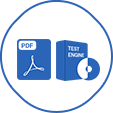Last Update 13 hours ago Total Questions : 50
The Palo Alto Networks XDR Engineer content is now fully updated, with all current exam questions added 13 hours ago. Deciding to include XDR-Engineer practice exam questions in your study plan goes far beyond basic test preparation.
You'll find that our XDR-Engineer exam questions frequently feature detailed scenarios and practical problem-solving exercises that directly mirror industry challenges. Engaging with these XDR-Engineer sample sets allows you to effectively manage your time and pace yourself, giving you the ability to finish any Palo Alto Networks XDR Engineer practice test comfortably within the allotted time.
How are dynamic endpoint groups created and managed in Cortex XDR?
Which components may be included in a Cortex XDR content update?
A security audit determines that the Windows Cortex XDR host-based firewall is not blocking outbound RDP connections for certain remote workers. The audit report confirms the following:
All devices are running healthy Cortex XDR agents.
A single host-based firewall rule to block all outbound RDP is implemented.
The policy hosting the profile containing the rule applies to all Windows endpoints.
The logic within the firewall rule is adequate.
Further testing concludes RDP is successfully being blocked on all devices tested at company HQ.
Network location configuration in Agent Settings is enabled on all Windows endpoints.What is the likely reason the RDP connections are not being blocked?
An XDR engineer is creating a correlation rule to monitor login activity on specific systems. When the activity is identified, an alert is created. The alerts are being generated properly but are missing the username when viewed. How can the username information be included in the alerts?
What happens when the XDR Collector is uninstalled from an endpoint by using the Cortex XDR console?
What is the earliest time frame an alert could be automatically generated once the conditions of a new correlation rule are met?
When using Kerberos as the authentication method for Pathfinder, which two settings must be validated on the DNS server? (Choose two.)

